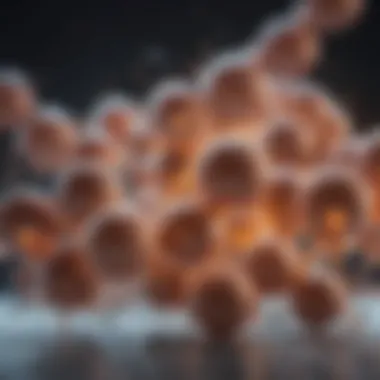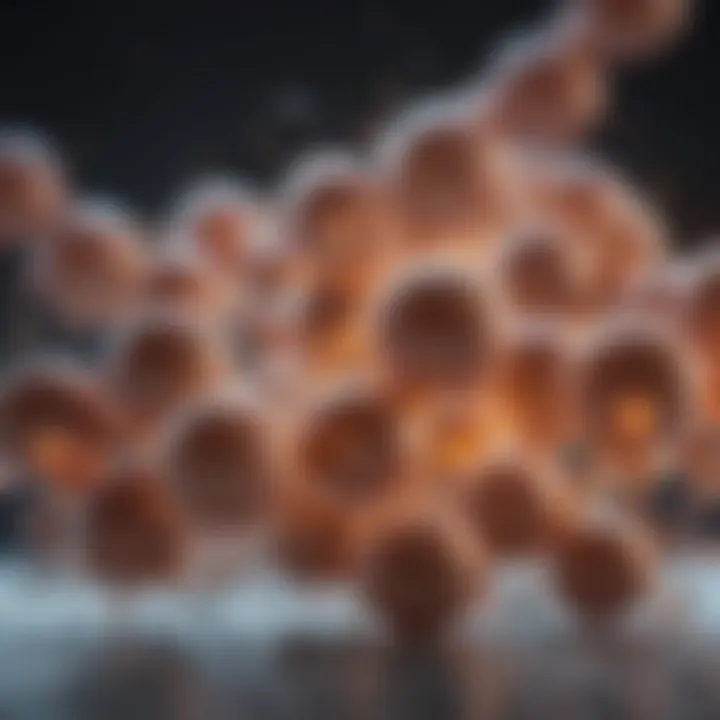Biochemical Processes of Ammonia Formation in Humans


Intro
Ammonia (NH₃) is an important metabolic product of the human body. Its formation is crucial for maintaining nitrogen balance and serves several functions in physiological processes. However, while ammonia plays essential roles, accumulation in excess can have deleterious effects. Thus, understanding how ammonia is produced and managed within the body is critical. This exploration covers the biochemical pathways involved in ammonia formation, its sources, and the health implications associated with its varying levels.
Research Overview
Methodological Approaches
Research into ammonia formation utilizes multiple methodologies. Different techniques help map biochemical pathways that lead to ammonia generation. Techniques like mass spectrometry and nuclear magnetic resonance spectroscopy identify and quantify ammonia levels in biological samples. Animal models, human studies, and in vitro experiments often provide insight into metabolic processes. The integration of these approaches allows for more comprehensive findings.
Significance and Implications
The significance of studying ammonia formation is twofold. First, it helps in understanding metabolic disorders where ammonia clearance is compromised, such as liver disease and urea cycle disorders. Second, it highlights how diet and gut microbiota influence ammonia levels. As our diet affects the types of proteins consumed, their metabolism can impact ammonia production. Thus, effective management of ammonia levels can potentially mitigate health risks associated with various diseases.
"Understanding the mechanisms of ammonia production and clearance remains vital for clinical applications and dietary guidelines."
Sources of Ammonia Generation
Protein Metabolism
A major source of ammonia is the breakdown of proteins. When proteins are metabolized, nitrogen is released as ammonia. This occurs mainly in the liver through a process known as deamination, where amino acids lose their amino group. The ammonia generated can then be converted into urea, which is excreted via urine. The efficiency of this process is crucial for regulating ammonia levels.
Gut Microbial Activity
The gut microbiome also contributes significantly to ammonia production. Certain bacteria found in the intestines metabolize non-digestible proteins and amino acids, generating ammonia as a byproduct. This microbial activity can vary widely among individuals, which potentially influences overall ammonia levels in the body.
Other Factors Influencing Ammonia Levels
Several factors influence the formation and accumulation of ammonia:
- Diet: High-protein diets increase ammonia production.
- Hydration: Adequate water intake is necessary for proper urinary excretion of ammonia.
- Health Conditions: Liver function and metabolic disorders can hinder ammonia processing.
Current Trends in Science
Innovative Techniques and Tools
Recent advancements in technology have improved our understanding of ammonia production. High-throughput sequencing offers insights into the gut microbiome's role in ammonia generation. Furthermore, new analytical tools are developed to assess ammonia levels more precisely in biological samples.
Interdisciplinary Connections
The study of ammonia formation connects various fields, including biochemistry, nutrition, and microbiology. Researchers from these disciplines collaborate to explore how dietary patterns and microbial composition relate to ammonia metabolism.
This through look helps establish a comprehensive perspective on the significance of nitrogen balance in human health.
Prelims to Ammonia in the Body
The formation of ammonia within the human body is a critical biochemical process that warrants thorough exploration. Understanding how ammonia is generated, its roles in metabolism, and its potential health implications is essential for students, researchers, and professionals in the medical and biochemical fields. Ammonia's dual nature as both a product of nitrogen metabolism and a toxic compound means that its levels must be rigorously managed. This section sets the stage for a comprehensive discussion of ammonia, illuminating its significance in biological processes.
Definition and Chemical Structure of Ammonia
Ammonia, chemically known as NH₃, is a simple molecule consisting of one nitrogen atom bonded to three hydrogen atoms. This molecular structure allows ammonia to exist as a colorless gas at room temperature, with a distinct odor. In a biological context, ammonia is formed predominantly as a byproduct of amino acid catabolism. Its basic nature means that it readily dissolves in water, forming ammonium ions (NH₄⁺). This transformation is crucial as many biological systems operate efficiently with ions rather than gases.
Understanding the basic structure of ammonia is important. This knowledge is fundamental for grasping how ammonia participates in various metabolic pathways. Its simplicity is contrasted by the complexity of the roles it plays in human physiology.


Significance of Ammonia in Metabolism
Ammonia plays multiple roles in human metabolism. On one hand, it serves as an important nitrogen source for the synthesis of amino acids and nucleotides. Many organisms rely on ammonia for replenishing necessary nitrogen compounds that are integral to building proteins and DNA. On the other hand, ammonia can also become toxic when accumulated excessively in the bloodstream.
The significant roles of ammonia in metabolism can be summarized as follows:
- Nitrogen Donor: Ammonia is a key nitrogen donor in biosynthetic reactions, contributing to the synthesis of important biomolecules.
- Central Role in Urea Cycle: The urea cycle converts excess ammonia into urea, which is excreted in urine, thus preventing the accumulation of toxic ammonia.
- Energy Metabolism: Ammonia can influence energy metabolism by affecting the synthesis and breakdown of key metabolites.
Primary Sources of Ammonia in Human Metabolism
In understanding ammonia's role within the human body, it is essential to focus on the primary sources of this compound. Ammonia is not just a waste product; it is a crucial element in various metabolic processes. Recognizing how it is produced can help in grasping its significance and the implications of elevated levels.
Protein Catabolism
Protein catabolism is one of the main contributors to ammonia production in the human body. When proteins are ingested, they undergo digestion and are broken down into their constitutive amino acids. This breakdown is vital as amino acids serve as building blocks for numerous biological functions. However, excess amino acids, or those not needed for protein synthesis, must be processed further through catabolism.
During this process, the amino group of the amino acids is removed through a reaction known as deamination. The removal of this amino group results in the formation of ammonia. The liver primarily facilitates this process, efficiently converting ammonia into urea. This conversion is essential, as urea is significantly less toxic than ammonia and can be excreted through urine, maintaining nitrogen balance in the body.
Deamination Processes
Deamination is the process where an amino group is removed from an amino acid. It serves as a pivotal pathway for nitrogen disposal in mammals. The enzymes involved in deamination selectively remove amino groups and convert them into ammonia, which, as noted, is subsequently transformed into urea for excretion.
There are generally two types of deamination: oxidative and non-oxidative deamination. The oxidative process usually involves the enzyme glutamate dehydrogenase, while the non-oxidative version may occur via transaminases. Both processes are significant in regulating amino acids and contribute to the ammonia pool of the body. Overall, efficient deamination is vital. If the rate of deamination exceeds the urea cycle's capacity, ammonia will accumulate, which can lead to toxic effects.
"The balance between protein intake, catabolism, and urea synthesis is critical for maintaining ammonia levels in check."
Microbial Contributions from the Gut Flora
The gut microbiome plays a notable role in ammonia production. Various bacteria in the intestines can break down dietary proteins and release ammonia as a byproduct of their metabolic activity. This microbial contribution is especially significant, as it can account for a large portion of the total ammonia generated within the human body.
Some bacteria in the gut flora can also produce ammonia through fermentation processes. While microbial ammonia production is a natural occurrence, elevation in dietary protein intake can increase the activity of these bacteria, potentially leading to heightened ammonia levels.
It is crucial to understand that this process is dynamic and influenced by the balance of gut microbiota. An imbalance, known as dysbiosis, may result in the overproduction of ammonia, which can have systemic effects, impacting liver function and overall health.
In summary, protein catabolism, deamination processes, and contributions from gut flora are fundamental sources of ammonia in human metabolism. Understanding these sources can elucidate how dietary choices and health conditions can affect ammonia levels and, consequently, overall human health.
Ammonia Production Pathways
The pathways involved in ammonia production are essential for understanding how this compound is formed and its role within the human body. Ammonia is a byproduct of various metabolic processes, and its production is not merely incidental. Rather, it reflects the balance of nitrogen metabolism, which is crucial for numerous bodily functions. The following sections will explore the specific pathways that lead to ammonia's formation, focusing on the urea cycle, the metabolism of glutamine and glutamate, and the influence of ketogenesis.
Urea Cycle and Nitrogen Excretion
The urea cycle, often referred to as the ornithine cycle, is a fundamental metabolic pathway responsible for removing excess nitrogen from the body. This cycle transforms ammonia, which is toxic at elevated levels, into urea, which is far less harmful and can be easily excreted through urine. The primary organs involved in this cycle are the liver and kidneys.
Overall, the urea cycle functions through a series of enzymatic reactions:
- Carbamoyl phosphate synthesis: Ammonia combines with bicarbonate to form carbamoyl phosphate.
- Ornithine cycle: The carbamoyl phosphate then enters the ornithine cycle to yield urea and regenerate ornithine.
- Excretion: Urea is released into the bloodstream and eventually removed from the body, primarily through the kidneys.
This cycle not only helps in detoxifying ammonia but also plays a role in maintaining nitrogen balance in the body. Disruptions in the urea cycle can lead to conditions such as hyperammonemia, where ammonia accumulates and leads to severe health issues.
Glutamine and Glutamate Metabolism
Glutamine and glutamate are amino acids that play prominent roles in managing ammonia levels. Glutamine, in particular, serves as a major nitrogen donor in various metabolic processes. It can be converted into glutamate through deamination.


- Role of Glutamate: When glutamate loses an amine group, it releases ammonia. This reaction is essential for regulating ammonia levels, especially in times of metabolic stress. The process highlights the relationship between amino acid metabolism and ammonium dynamics.
- Importance of Glutaminase: The enzyme glutaminase facilitates this conversion and is critical in tissues with high ammonium exchanges, such as the liver and kidneys.
Understanding how these amino acids impact ammonia production helps elucidate their roles in maintaining homeostasis when subject to physiological changes or pathological conditions.
Impact of Ketogenesis
Ketogenesis refers to the process through which the body produces ketone bodies from fatty acids. This metabolic state often occurs during prolonged fasting, low-carbohydrate diets, or uncontrolled diabetes.
During ketogenesis, certain amino acids are converted into ketone bodies, which can alter the nitrogen metabolism in the body. The formation of ketones necessitates a delicate balance since they can affect the overall production of ammonia in the liver.
Significant factors to consider are:
- Increased Ammonia Production: As ketone bodies rise, so too can ammonia levels, due to the breakdown of specific amino acids like leucine and isoleucine.
- Energy Utilization: While ketone bodies provide an energy source, their generation signifies a shift in metabolic pathways that can influence ammonia dynamics.
Through these interconnected pathways, we can appreciate the intricate balance between energy production and amino acid metabolism. Together, they illustrate how ammonia formation is not simply a byproduct but a reflection of the body’s metabolic state.
Factors Influencing Ammonia Levels
Understanding the factors that influence ammonia levels in the human body is crucial. Ammonia regulation is vital for metabolic homeostasis. Various elements, including diet, health conditions, and even exercise, can significantly affect its production and clearance. These factors shed light on how ammonia functions within physiological limits and highlight the delicate balance required for optimal health.
Dietary Influences on Ammonia Production
Diet plays a pivotal role in ammonia formation. High protein intake often correlates with increased ammonia levels. Proteins break down into amino acids, many of which undergo deamination, releasing ammonia as a byproduct. Foods such as meats, fish, and dairy are significant contributors. The frequency and manner in which these foods are consumed can also influence ammonia synthesis.
- Protein Quantity: Consuming large amounts of protein increases ammonia production.
- Protein Quality: The type of protein consumed matters. Animal proteins may yield more ammonia than plant proteins.
Furthermore, it’s essential to consider the balance of essential amino acids. An imbalance in amino acids can lead to inefficient metabolism and higher ammonia levels. Overall, dietary choices have a direct impact on ammonia management in the body.
Health Conditions Affecting Ammonia Levels
Liver Dysfunction
Liver dysfunction significantly contributes to altered ammonia metabolism. The liver is responsible for converting ammonia into urea through the urea cycle. When liver function declines, this conversion process is impaired, leading to elevated ammonia levels in the bloodstream.
- Key Characteristic: When the liver is not functioning properly, ammonia accumulates.
- Significance: Liver dysfunction is a common aspect in conditions like cirrhosis and hepatitis, making it a critical focus of this article.
The liver’s inability to detoxify ammonia can lead to serious neurological complications, underscoring the importance of understanding this condition in the context of ammonia formation.
Renal Insufficiency
Renal insufficiency also affects ammonia levels. The kidneys play a crucial role in nitrogen excretion, including ammonia. When the kidneys fail to function effectively, ammonia clearance is compromised, resulting in increased serum ammonia levels.
- Key Characteristic: Reduced kidney function leads to ammonia retention in the body.
- Importance: Chronic kidney disease is prevalent, making it relevant to our topic on ammonia management.
Understanding renal insufficiency enhance our comprehension of ammonia dynamics within the body, especially its excretion patterns.
Metabolic Disorders
Metabolic disorders involving amino acids can significantly impact ammonia production and tolerance. Conditions such as urea cycle disorders disrupt normal ammonia detoxification, leading to its accumulation.
- Key Characteristic: These disorders often result in hyperammonemia and associated neurological complications.
- Relevance: Such disorders draw attention to the biological mechanisms underlying ammonia metabolism and are essential for understanding broader metabolic implications.
Recognizing metabolic disorders aids in the formulation of disease-specific strategies that address ammonia elevation.


Exercise and Ammonia Production
Exercise is known to influence ammonia levels within the body. During intense physical activity, protein catabolism can increase, leading to elevated ammonia production. The body metabolizes amino acids to fuel energy demands, especially during endurance activities.
Moreover, the byproducts of protein metabolism, including ammonia, may accumulate if the urea cycle is unable to keep pace with production during strenuous exercise.
- Intensity of Exercise: Higher intensity workouts tend to produce more ammonia.
- Adaptation: Regular training can enhance the body’s ability to manage ammonia levels over time.
Understanding how exercise impacts ammonia production is vital for athletes and individuals seeking better metabolic health.
Health Implications of Elevated Ammonia Levels
Understanding the health implications of elevated ammonia levels is vital for various reasons. Ammonia, a byproduct of protein metabolism, can become toxic if not adequately processed by the body. When ammonia accumulates, it leads to significant physiological and neurological issues. These effects can affect a person’s quality of life and overall health, making this topic crucial for healthcare professionals, researchers, and students alike.
Toxic Effects of Ammonia Accumulation
Ammonia has a low threshold for toxicity in the human body. Elevated levels, a condition known as hyperammonemia, can disrupt normal metabolic functions, leading to a cascade of health problems. One of the primary dangers includes its impact on the liver. The liver is responsible for converting ammonia into urea through the urea cycle. If this process is overwhelmed, ammonia builds up in the bloodstream. This toxic buildup can result in symptoms such as:
- Nausea and vomiting
- Weakness or fatigue
- Confusion
- Altered consciousness
In severe cases, it can cause hepatic encephalopathy, potentially leading to coma or death. Thus, understanding the toxic effects of ammonia accumulation is crucial for effective management and treatment.
Neurological Consequences
The neurological effects of elevated ammonia levels are particularly concerning. Ammonia can cross the blood-brain barrier, where it disrupts neurotransmitter balance and compromises brain function. This disruption can lead to symptoms ranging from mild confusion to severe neurological deficits. Some specific neurological consequences include:
- Cognitive impairments, affecting memory and learning.
- Mood disturbances, including irritability and depression.
- Severe symptoms that may include seizures or coma in advanced cases.
Neurological health is sensitive to biochemical changes in the body. Elevated ammonia levels pose significant risks to an individual's cognitive and emotional state.
Management and Treatment Strategies
Managing elevated ammonia levels requires a multifaceted approach. The treatment focuses on reducing ammonia production and promoting its elimination from the body. Key strategies include:
- Dietary modifications: Reducing protein intake may help lower ammonia production from protein catabolism.
- Medication: Lactulose is an example of a medication that can help lower ammonia levels by promoting intestinal excretion.
- Treating underlying conditions: It is essential to address any liver or kidney dysfunction, as these can exacerbate ammonia accumulation.
Effective management is crucial to prevent the neurological and physiological complications associated with elevated ammonia levels.
In summary, the health implications of elevated ammonia levels necessitate careful monitoring and intervention. Understanding these implications supports better clinical outcomes and enhances patient care.
Closure and Future Research Directions
The study of ammonia formation in the human body provides essential insights into metabolic processes. This article outlines various pathways of ammonia production, including protein catabolism and microbial contributions. Understanding these pathways is crucial for both health and disease management. The importance of maintaining balanced ammonia levels cannot be overstated. Elevated ammonia can lead to serious health consequences, including neurological issues. Research in this area is ongoing and will inform treatment strategies moving forward.
Summary of Key Findings
The formation of ammonia is a complex, multifaceted process in the human body. The key findings presented in the article include:
- Sources of Ammonia: Ammonia is primarily produced through the breakdown of proteins and the deamination of amino acids. Additionally, gut flora play a significant role in generating ammonia.
- Pathways for Clearance: The urea cycle serves as the primary pathway for ammonia detoxification. Glutamine and glutamate metabolism are also critical for managing ammonia levels.
- Influencing Factors: Dietary habits, underlying health conditions, and physical activity all influence ammonia production. These elements can either exacerbate or alleviate elevated ammonia levels.
Implications for Health and Disease Management
Raising awareness about ammonia's role is vital for enhancing health strategies. Elevated ammonia levels can indicate potential issues such as liver dysfunction or renal insufficiency. Thus, clinicians need to monitor ammonia levels as part of routine metabolic assessments. Effective management could include dietary adjustments and healthcare interventions aimed at reducing ammonia accumulation. This understanding can lead to better outcomes for patients with metabolic disorders or those undergoing intensive exercise regimens.
Call for Further Research
To enhance our understanding of ammonia in human health, further research is necessary. Future studies should focus on the following aspects:
- Mechanisms of Ammonia Clearance: Investigate the pathways that facilitate ammonia detoxification more thoroughly. Understanding these mechanisms can assist in developing better therapeutic options.
- Impact of Diet on Ammonia Levels: Continued exploration of the relationship between nutrition and ammonia production may yield beneficial dietary recommendations.
- Intervention Strategies: Developing and testing interventions that target ammonia elevation is crucial for developing better management strategies.
In summary, a deep analysis of ammonia formation and its implications in health lays the groundwork for critical advancements in metabolic health. Strategic research efforts will help pave the way for improving diagnosis and treatment of related disorders.



